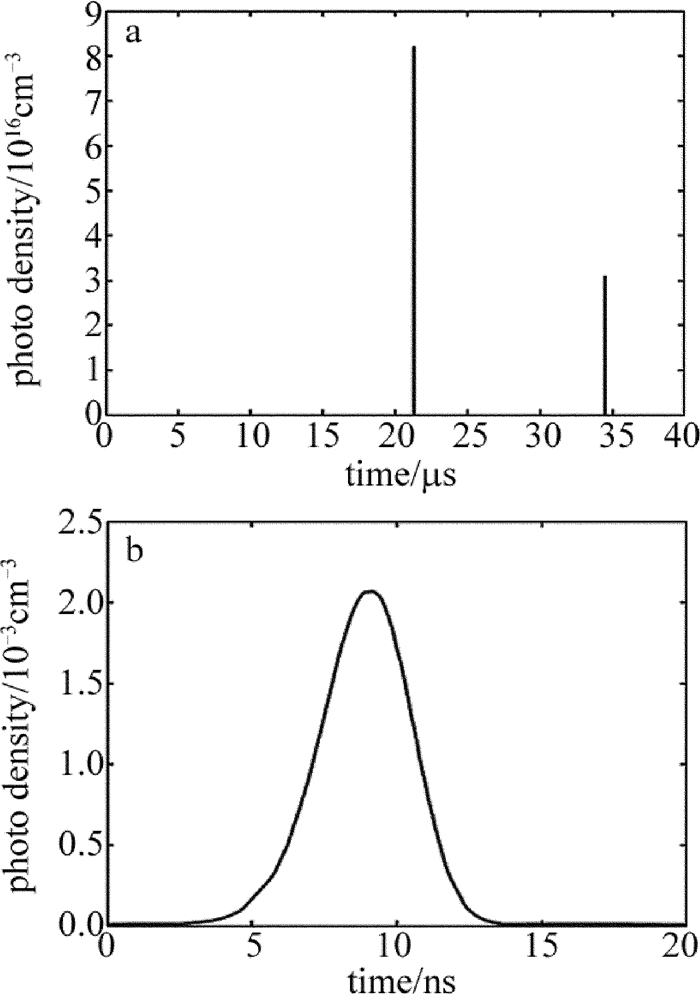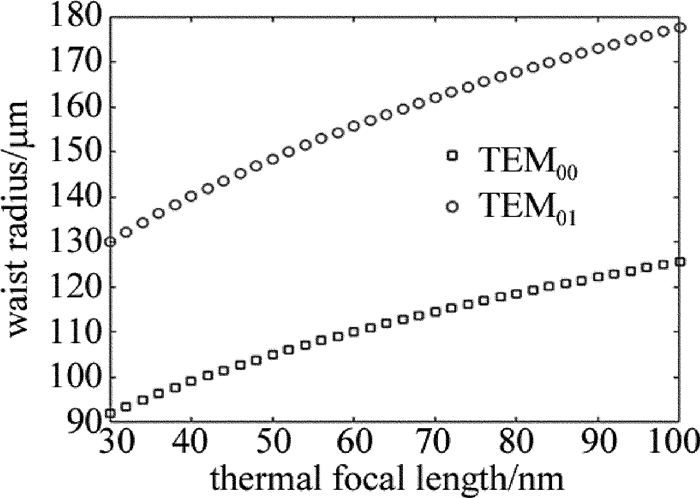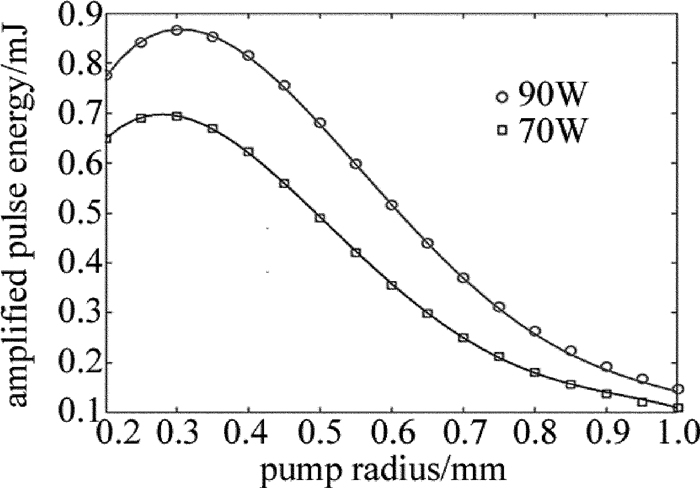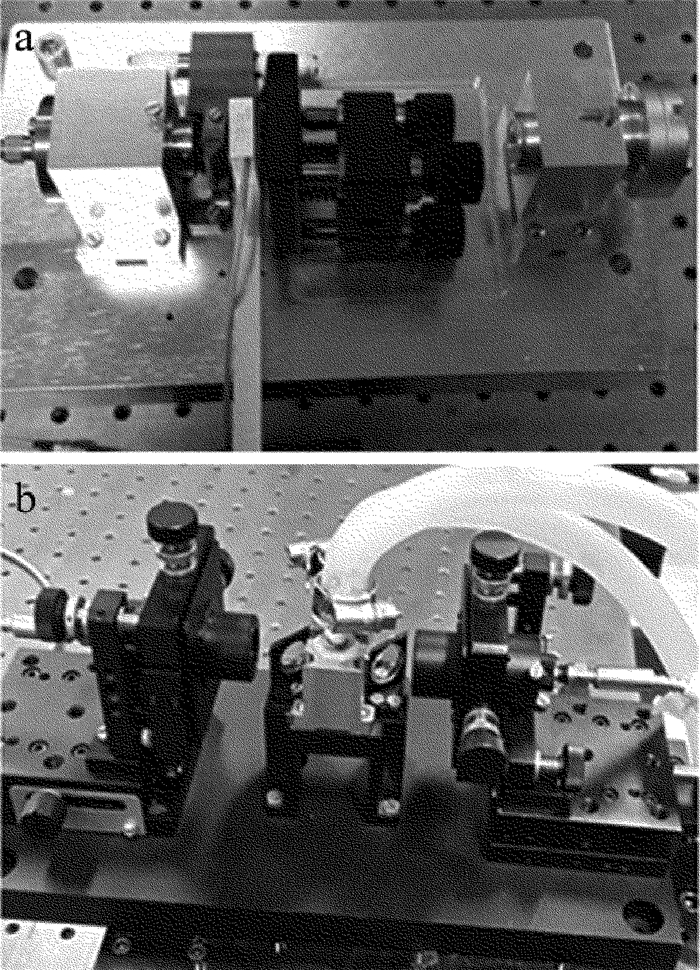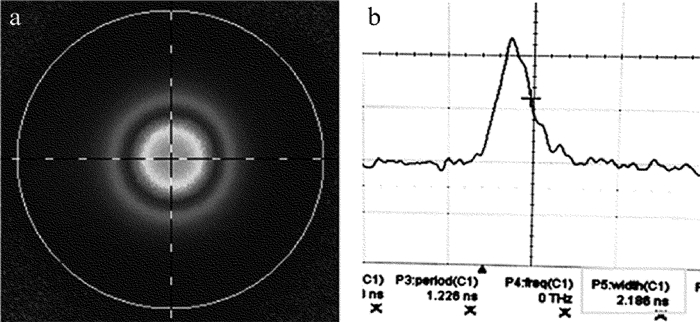Study on an acousto-optical Q-switched Nd: YVO4 laser with 25kHz repetition rate and about 2ns pulse duration
-
摘要: 为了获得高重频窄脉冲高光束质量激光输出,采用LD抽运Nd:YVO4晶体声光调Q方案,进行了相关理论分析和实验验证,振荡级获得了重频25kHz、单脉冲能量22.4μJ、脉冲宽度2.19ns、光束质量因子M2 < 1.2的种子激光,光光转换效率为24.3%;放大级获得了重频25kHz、单脉冲能量585μJ、脉冲宽度2.26ns、光束质量因子M2 < 1.7的激光输出,提取效率为15.6%。结果表明,采用LD抽运Nd:YVO4晶体声光调Q方案能够获得高重频、窄脉冲、高光束质量激光输出,其实验现象与理论计算结果较为符合。Abstract: In order to achieve laser output with high repetition rate, short pulse duration and high beam quality, a LD pumped acousto-optically Q-switched Nd:YVO4 solid-state laser was designed and set up. In the lasing experiments, the seed laser with an excellent beam quality was obtained from the master oscillator. The parameters of the seed laser are 25kHz repetition, 22.4μJ pulse energy, 2.19ns pulse duration, 24.3% optical-to-optical conversion. efficiency and M2 < 1.2. The output laser from the power amplifier is with 25kHz repetition, 585μJ pulse energy, 2.26ns pulse duration, 15.6% extraction efficiency and M2 < 1.7. The result shows that laser output with high repetition rate, short pulse duration and high beam quality could be achieved by LD pumped acousto-optically Q-switched Nd:YVO4 lasers and the experimental results are almost in accordance with the theoretical calculation results.
-
Keywords:
- lasers /
- high repetition /
- short pulse /
- acousto-optically Q-switched
-
-
Table 1 Parameters of output coupler reflectivity, pulse width and energy
output coupler reflectivity/% pulse width/ns energy/μJ average power/W 50 1.66 35.2 0.88 60 1.69 34.1 0.85 70 1.84 32.4 0.81 -
[1] ZHAO H L, FAN Y Ch, SUN Y Ch, et al. Review about 3-D laser ra-dar system based on Geiger-mode APD array[J]. Laser & Infrared, 2013, 43(10):1083-1088(in Chinese).
[2] WANG F. Researches on performance and range accuracy of laser imaging system based on Geiger mode detectors[D]. Harbin: Harbin Institute of Technology, 2010: 7-14(in Chinese).
[3] MARIUS A A, BRIAN F A, DANIEL G F, et al. Three-dimensional imaging laser radars with Geiger-mode avalanche photodiode arrays[J]. Mit Lincoln Laboratory Journal, 2002, 13(2):351-370. http://cn.bing.com/academic/profile?id=71ed8e3bf3059932dafe211f2cf3926c&encoded=0&v=paper_preview&mkt=zh-cn
[4] ZAYHOWSKI J J, DILL L C. Diode-pumped microchip lasers electro-optically Q switched at high pulse repetition rates[J]. Optics Letters, 1992, 17(17):1201-1203. DOI: 10.1364/OL.17.001201
[5] PLAESSMANN H, YAMADA K S, RICH C E. Subnanosecond pulse generation from diode-pumped acousto-optically Q-switched solid-state lasers[J]. Applied Optics, 1993, 32(33):6616-6619. DOI: 10.1364/AO.32.006616
[6] MARINO R M, STEPHENS T, HATCH R E, et al. A compact 3-D imaging laser radar system using Geiger-mode APD arrays:system and measurements[J].Proceedings of the SPIE, 2003, 5086:1-15. DOI: 10.1117/12.501581
[7] WANG X, SUN Zh, CHENG G H. High repetition rate and short pulse width electro-optic Q-switched Nd:YVO4 laser[J]. Chinese Journal of Lasers, 2016, 43(6):0601007(in Chinese). DOI: 10.3788/CJL
[8] DONG J, UEDA K, SHIRAKAWA A, et al. Composite Yb:YAG/Cr4+:YAG ceramics picosecond microchip lasers[J]. Optics Express, 2007, 15(22):14516-14523. DOI: 10.1364/OE.15.014516
[9] CAI H, ZHOU J, ZHAO H M, et al. Continuous-wave and Q-switched performance of an Yb:YAG/YAG composite thin disk ceramic laser pumped with 970nm laser diode[J]. Chinese Optics Letters, 2008, 6(11):852-854. DOI: 10.3788/COL
[10] DU K M, LI D J, ZHANG H L, et al. Electro-optically Q-switched Nd:YVO4 slab laser with a high repetition rate and a short pulse width[J]. Optics Letters, 2003, 28(2):87-89. DOI: 10.1364/OL.28.000087
[11] DU Ch L, LIU J H, WANG Zh P, et al. LD-pumped acousto-optic Q-switched Nd:YVO4 laser with high repetition rates and short pulse width[J]. Chinese Journal of Lasers, 2002, 29(6):489-491(in Chinese).
[12] ROBERT D S, VICTOR L, KALIN S. Short pulse, high-repetition rate, passively Q-switched Er:yttrium-aluminum-garnet laser at 1.6 microns[J]. Applied Physics Letters, 2005, 87(24):24118. http://d.old.wanfangdata.com.cn/NSTLQK/NSTL_QKJJ029961841/
[13] WANG J G, SUN Z, JIANG M H, et al. A high-power 1ns Nd:YAG laser system[J]. Journal of Optoelectronics·Laser, 2012, 23(7):1257-1262(in Chinese). http://en.cnki.com.cn/Article_en/CJFDTOTAL-GDZJ201207008.htm
[14] ZHANG D Y, XU L J, ZHAO H, et al. Small-sized and A-O Q-switched DPL with high repetition rate and short pulse duration[J]. Infrared and Laser Engineering, 2007, 36(6):790-793(in Chinese). http://pubmedcentralcanada.ca/pmcc/articles/PMC2465309/
[15] ZHONG G Sh, MAO X J, BI G J, et al. Lasers with narrow pulse width and high beam quality[J]. Laser Technology, 2013, 37(6):766-768(in Chinese). http://en.cnki.com.cn/Article_en/CJFDTotal-JGJS201306014.htm
[16] WALTER K. Solid-state laser engineering[M]. New York, USA:Springer, 2006:11-37.
[17] LÜ B D. Laser optics:laser beam propagation and beam quality control[M]. Chengdu:Press of Sichuan University, 1992:35-44(in Chinese).
[18] PEARCE S, IRELAND C L, DYER P E. Simplified analysis of double-pass amplification with pulse overlap and application to Nd:YVO4 laser[J]. Optics Communications, 2005, 255(4):297-303. http://www.sciencedirect.com/science/article/pii/S0030401805005675



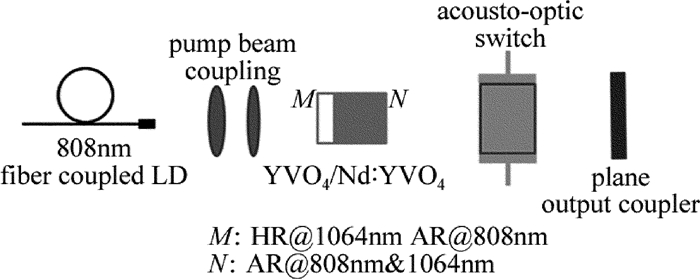
 下载:
下载:

